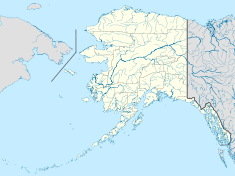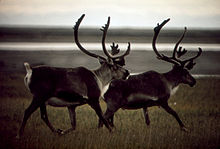- Prudhoe Bay Oil Field
-
Prudhoe Bay oil field Location of Prudhoe Bay oil field Country United States Region Alaska North Slope Offshore/onshore onshore Coordinates 70°18′24″N 148°43′57″W / 70.30667°N 148.7325°WCoordinates: 70°18′24″N 148°43′57″W / 70.30667°N 148.7325°W Operator(s) BP Partners BP, ExxonMobil, ConocoPhillips Alaska Field history Discovery March 12, 1968 by ARCO and Exxon's Prudhoe Bay State #1 well Start of production June 20, 1977 Peak of production 1.5 million barrels per day (240,000 m3/d) Peak year 1979 Production Current production of oil 660,000 barrels per day (~3.3×107 t/a) Year of current production of oil 2010 Estimated oil in place 25,000 million barrels (~3.4×109 t) Estimated gas in place 26,000 billion cubic feet (740×109 m3) Producing formations Sadlerochit Prudhoe Bay Oil Field is a large oil field on Alaska's North Slope. It is the largest oil field in both the United States and in North America, covering 213,543 acres (86,418 ha) and originally containing approximately 25 billion barrels (4.0×109 m3) of oil.[1] The amount of recoverable oil in the field is more than double that of the next largest field in the United States, the East Texas oil field. The field is operated by BP; partners are ExxonMobil and ConocoPhillips Alaska.
Contents
Location
The field is located 400 miles (640 km) north of Fairbanks and 650 miles (1,050 km) north of Anchorage, 250 miles (400 km) north of the Arctic Circle, and 1,200 miles (1,900 km) from the North Pole.[1]
History
Commercial oil exploration started in Prudhoe Bay area in the 1960s and the field was discovered on March 12, 1968, by Atlantic Richfield Company (ARCO) and Exxon, with the well Prudhoe Bay State #1.[1] Drilling sites for the discovery and confirmation wells were staked by geologist Marvin Mangus. In 1974 the State of Alaska's Division of Geological & Geophysical Surveys estimated that the field held 10 billion barrels (1.6×109 m3) of oil and 26 trillion cubic feet (740×109 m3) of natural gas.[2] Production did not begin until June 20, 1977 when the Alaska Pipeline was completed.[1] The field was initially operated as two separate developments, the BP Western Operating Area (WOA: Oil Rim) and the ARCO Eastern Operating Area (EOA: Gas Cap).
Cumulative North Slope oil peaked in 1989 at 2 million barrels per day (320×103 m3/d) (Greater Prudhoe Bay: 1.5 million barrels per day (240×103 m3/d), but had fallen to 943,000 barrels per day (149,900 m3/d) in 2005,[3] while Greater Prudhoe averaged 411,000 barrels per day (65,300 m3/d) in December, 2006 and Prudhoe itself averaged 285,000 barrels per day (45,300 m3/d).[4] Total production from 1977 through 2005 was 11 billion barrels (1.7×109 m3).
As of August 2006, BP estimated that 2 billion barrels (320×106 m3) of recoverable oil remain and can be recovered with current technology.[1][5]
Associated oil fields
The Milne Point oil field is 35 miles (56 km) west of Prudhoe Bay.
Geology
Oil, condensate and gas are produced from the Triassic, Ivishak sandstone. This reservoir was deposited as a complex amalgamation of fan deltas and alluvial fans. The oil is trapped in the Sadlerochit formation, a gravel and sandstone structure nearly 9,000 feet (2,700 m) under the surface. During the field’s early life the oilbearing sandstone in some locations was 600 feet (180 m) thick. Today, the oil bearing zone's average thickness is about 60 feet (18 m).
Stats
Statistics for the Greater Prudhoe Bay Field:[1]
- Discovery well: Prudhoe Bay State #1
- Discovery date: March 12, 1968
- Production start: June 20, 1977
- Total field area: 213,543 acres (864.18 km2)
- Oil production wells: 1114
- Total capacity: 25 billion barrels (4.0×109 m3)
- Produced: 11 billion barrels (1.7×109 m3)
- Total recoverable: 13 billion barrels (2.1×109 m3)
- Remaining recoverable: 2 billion barrels (320,000,000 m3)
- Peak production: 1.5 million barrels per day (240,000 m3/d) (1979)
- Natural gas:
- Total: 46×1012 cu ft (1,300 km3) (estimated)
- Recoverable: 26×1012 cu ft (740 km3)
- Greater Prudhoe Bay satellite fields:
- East Operating Area (formerly ARCO)(production start date: 1977)
- West Operating Area (BP Exploration)(production start date: 1977)
- Midnight Sun (production start date: 1998)
- Aurora (production start date: 2000)
- Orion (production start date: 2002)
- Polaris (production start date: 1999)
- Borealis (production start date: 2001)
- Ownership:
- BP Exploration (Operator): 26%
- ConocoPhillips Alaska Inc.: 36%
- ExxonMobil: 36%
- Others: 2%
March 2006 oil spill
On March 2, 2006, a worker for BP Exploration (Alaska) discovered a large oil spill in western Prudhoe Bay. Up to 267,000 US gallons (1,010,000 L) were spilled, making it the largest oil spill on Alaska's north slope to date.[6] The spill was attributed to a pipeline rupture.
According to King 5, BP paid a $20 million fine for the spill.
On November 3, 2008, BP issued a response to King 5 the report stating that they "had no record that any concerns about corrosion leading to an oil transit line breach in the foreseeable future ever were communicated to BP."
August 2006 shutdown
The March 2006 oil spill led the United States Department of Transportation to mandate that the transit lines be inspected for corrosion. As a result, BP announced on 6 August 2006 they had discovered severe corrosion, with losses of 70 to 81 percent in the 3/8-inch of the wall thickness of the pipe. Oil leaking was reported in one area, with the equivalent of four to five barrels of oil spilled.[7] The damage required replacement of 16 of 22 miles (35 km) of pipeline at the Prudhoe Bay. BP said it was surprised to find such severe corrosion and that it had been 14 years since they had used a pipeline inspection gauge ("pig") to clean out its lines because the company believed the use of the rigging equipment might damage pipe integrity.[8] BP Exploration announced that they were shutting down the oil field indefinitely, due to the severe corrosion and a minor leak in the oil transit lines.[8][9] This led to an 8% reduction in the amount of oil produced by the United States of America, as Prudhoe Bay is the country's largest oil producer, producing over 400,000 barrels per day (64,000 m3/d).
BP initially estimated up to 2 to 3 months before the pipelines would be fully operational.[8] This caused increases in world oil prices,[10] and BP revised the estimated operational date to January 2007.[11] London brent crude hit an intra-day high of $77.73/barrel, the all-time high, at that time, being $78.18/barrel. United States crude oil peaked at $76.67/barrel. The State of Alaska, which gets most of its revenue from taxing the oil industry, lost as much as $6.4 million each day until production restarted.[12]
No part of the Alaska Pipeline was affected, although Alyeska said that lower crude oil volumes could slow pumping during the BP shutdown.[13]
The field has since reopened. In mid-June 2007, however, a small leak occurred in one of the pipelines that connect the field to the Trans-Alaska Pipeline, shutting down the field for a week.[14]
In March 2009 the State of Alaska sued BP in matter number 3AN-09-06181-CI alleging that BP was negligent in its management of rigging operations and corrosion control in the transit lines leading from the field into pumping station one of the Trans Alaska Pipeline. The state is seeking damages for lost royalty and tax revenues. The matter is still being disputed.
References
- ^ a b c d e f Prudhoe Bay Fact Sheet. BP. August 2006. (Adobe Acrobat *.PDF document)
- ^ Estimated Speculative Recoverable Resources of Oil and Natural Gas in Alaska. Division of Geological & Geophysical Surveys. Department of Natural Resources. State of Alaska. January 1974. (Adobe Acrobat *.PDF document)
- ^ "US Republicans set to turn Alaska's Arctic National Wildlife Refuge into oilfield". Bellona.com. 14 April 2005. http://www.bellona.no/en/energy/37733.html. Retrieved 2006-08-08.
- ^ "Alaska North Slope production breaks 800,000 bbl/d (130,000 m3/d) barrier". Petroleum News. 7 January 2007. http://www.petroleumnews.com/pntruncate/218834563.shtml.
- ^ BP Plans to Pull Another 2B Barrels of Oil from Alaska's Prudhoe Bay. Rigzone. February 22, 2008
- ^ "Alaska hit by 'massive' oil spill". BBC News. 11 March 2006. http://news.bbc.co.uk/1/hi/world/americas/4795866.stm. Retrieved 2006-08-08.
- ^ "Biggest Oil Field in U.S. Is Forced to Stop Pumping". New York Times. 2006-08-08. http://www.theledger.com/apps/pbcs.dll/article?AID=/20060808/ZNYT01/608080426/1001/BUSINESS.
- ^ a b c Pemberton, Mary (8 August 2006). "Gas prices climb as oil pipeline in Alaska must be replaced". The Daily Texan. http://www.dailytexanonline.com/media/storage/paper410/news/2006/08/08/WorldNation/Gas-Prices.Climb.As.Oil.Pipeline.In.Alaska.Must.Be.Replaced-2143890.shtml?norewrite200608081122&sourcedomain=www.dailytexanonline.com. Retrieved 2006-08-08.[dead link]
- ^ "BP shutting top US oil field Prudhoe Bay due to spill". Reuters. 7 August 2006. http://today.reuters.co.uk/news/articlebusiness.aspx?type=businessNews&storyID=2006-08-07T014428Z_01_N06274365_RTRUKOC_0_UK-ENERGY-BP.xml. Retrieved 2006-08-08.
- ^ Raft, Anna (7 August 2006). "BP restart of Prudhoe Bay oil field may take months". MarketWatch. http://www.marketwatch.com/News/Story/Story.aspx?dist=newsfinder&siteid=google&guid=%7B6A81577A-0361-461D-BAE7-A963044C6768%7D&keyword=. Retrieved 2006-08-08.
- ^ "BP oil field 'closed until 2007'". CNN. August 8, 2006. http://www.cnn.com/2006/US/08/08/oilfield.shutdown/index.html. Retrieved 2006-08-08.[dead link]
- ^ Loy, Wesley (7 August 2006). "BP shuts down Prudhoe Bay". Anchorage Daily News. Archived from the original on 2006-08-19. http://web.archive.org/web/20060819055407/http://www.adn.com/money/industries/oil/story/8052561p-7945629c.html. Retrieved 2006-08-08.
- ^ Loy, Wesley, and Richard Richtmyer (August 8, 2006). "Massive repairs: BP admits corrosion control was inadequate, prepares to replace North Slope transit lines". Anchorage Daily News. Archived from the original on 2006-08-21. http://web.archive.org/web/20060821195145/http://www.adn.com/front/picture_inset/story/8054990p-7948041c.html. Retrieved 2006-08-08.
- ^ "BP to reopen oil pipeline in Alaska". The Scotsman. June 25, 2007. http://business.scotsman.com/utilities.cfm?id=988692007. Retrieved 2007-07-10.
Further reading
- Sweet, John M. (2008). Discovery at Prudhoe Bay. Blaine, Washington: Hancock House. pp. 312 p. ISBN 978-0-88839-630-3.
External links
- Milne Point goes mainstream. Inc. oilfield (Alaska Business Monthly, April, 1995.)
- Prudhoe Bay, Alaska Aerial photos from the Prudhoe Bay area, July 2010
Categories:- Oil fields in Alaska
- Economy of Alaska
- ARCO
- BP
- ConocoPhillips
- ExxonMobil
- Industry in the Arctic
- Geography of North Slope Borough, Alaska
Wikimedia Foundation. 2010.


